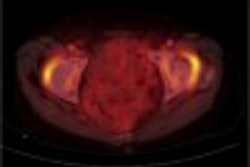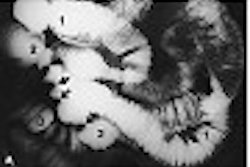CHICAGO - The Agatston score has officially been replaced by calcium mass for coronary artery calcium assessment. It has, at least, in the eyes of an international consortium of radiologists, physicists, and vendors that has labored for four years to settle on a new standard designed to work as well for electron-beam CT (EBCT) scanners as it does for multidetector-row CT (MDCT) machines.
Over the past several years, the use of cardiac-dedicated EBCT scanners made by Imatron (now owned by GE Medical Systems of Waukesha, WI) has been increasingly supplanted by MDCT machines that are installed by the thousands in facilities worldwide. EBCT assessment is still faster than the MDCT calcium scan (approximately 0.1 seconds exposure compared to 0.4 seconds for MDCT) and even approved by the FDA for calcium scoring -- a blessing not yet bestowed on MDCT. But compared to MDCT, the facilities that offer EBCT scans are harder to find, and that has made all the difference.
“The horse is out of the barn,” said Cynthia McCollough, Ph.D., with regard to the increasing use of MDCT vs. EBCT. “The positive aspect is that we have good patient access…. The problem: now that we have a lot of manufacturers we have many different ways to scan.”
McCollough discussed the consortium’s progress toward a unifying standard at a press conference Monday at the 2003 RSNA meeting.
The scientific literature, too, has evolved to form a sort of consensus in favor of calcium mass scoring compared with the alternatives: Agatston, volume scoring or some sort of hybrid method. And mass is widely considered the most likely to succeed in the critical issue of portability from scanner to scanner and vendor to vendor.
“We have adopted a meaningful physically-based well-defined quantification method…,” she said. “Patients who have a coronary artery scan can have it done anywhere from Memphis to Munich and still have confidence that that number means the same thing…. All the manufacturers have agreed to play by the same rules.”
The International Consortium for Standardization in Cardiac CT has worked with GE Medical Systems of Waukesha, WI, Siemens Medical Solutions of Malvern, PA; Toshiba America Medical Systems of Tustin, CA; and Bothell, WA-based Philips Medical Systems to gauge the precise output of their four- and 16-slice MDCT scanners using a standardized acrylic phantom loaded with a precise amount of calcium, McCullough said. The group has done the same for GE’s EBCT scanners. The recommended protocols have been adjusted to yield uniform signal and image noise output within a few percentage points across brands and models for small, medium, and large patients.
Still, the evidence supporting mass measurement has come mainly from the use of anthropomorphic phantoms, and McCollough acknowleged that the suitability of their method has not yet been proven definitively. “This last item is … to create an international Web-based epidemiological database of calcium scores along with patient (coronary) events,” she said. “But they have to be standardized to put meaningful data in the database so we can get meaningful results back.”
McCollough declined to provide recommended protocols for the scanners used in the project, but said the settings commonly used in the newer calcium scoring studies were similar to those used in the consortium's tests. Radiologists should contact their scanner manufacturers to get the exact protocols for each patient size and scanner model, she said.
McCollough listed the threshold for the presence of calcium at 100 mg of calcium per cubic centimeter, noting that the precise CT values or Hounsfield units representing the presence of calcium vary by scanner.
Meanwhile, she said, the manufacturers have been hard at work developing software to calculate the calcium mass score based on the new standardized output, which the group calls its recipe.
“It’s a step-by-step instruction that we give to all the manufacturers, and it says do this first: find the coronary arteries in the image,” McCollough said. “Then choose the appropriate calibration factor for that scanner for that size patient. Then, knowing that, you can take these CT numbers (HU) that vary from scanner to scanner, and convert them into something that can be calibrated -- the amount of calcium. Then we take all the pixels that meet certain criteria, and we’ve set the criteria very specifically, and you get a final score that is mass: milligrams of calcium (per cc).”
In addition to McCollough and colleagues at the Mayo Clinic, more than a dozen leading CT researchers are participating in the project, including CT pioneer Willi Kalender, Ph.D. and Stefan Ulzheimer, Ph.D. from the Institute for Medical Physics in Erlangen, Germany; Dr. Eric Hoffman from the University of Iowa; and Dr. Richard White from the Cleveland Clinic in Ohio, who provided the impetus for the consortium, McCollough said.
By Eric Barnes
AuntMinnie.com staff writer
December 2, 2003
Related Reading
Calcium-scoring methods study says it's all good, September 10, 2003
Coronary calcium scan gains ground as prognostic tool, August 6, 2003
Calcium mass measures coronary calcium best, June 17, 2003
New techniques boost accuracy of coronary calcium assessment, March 5, 2003
Study finds blacks have less coronary calcium than whites, February 17, 2003
Thin-collimation MDCT identifies more coronary calcium, December 18, 2002
Population-based study links coronary calcium and mortality, December 1, 2002
Technology keeps CT vital for coronary assessment, November 13, 2002
CT calcium scoring works, but what does it mean?, January 8, 2002
Copyright © 2003 AuntMinnie.com



















